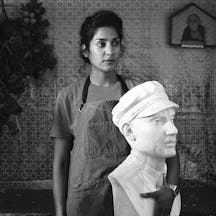Here inside my installation, it looks and sounds like a strange yoga studio or wellness retreat, where things do not appear as expected. See-through curtains enclose and soften the space, and have vintage films of people practising yoga projected onto them.
Some of the films have been hand-tinted with colour and sepia tones. These projected bodies move in strange choreographies, sometimes are synchronised, and sometimes stop abruptly and switch to another surface or disappear, to be replaced with a colour: red, yellow, brown. The colours are linked to chromotherapy, the practice of using colour to balance the body and heal it from ailments.
There is a black-and-white film of the yogi Swami Dev Murti. He occupies his own space in the periphery of the room, and the intensity of his movements are sometimes beautiful and at other points disturbing.
He is the only person of colour. In all the other films the people are white. Words that you might hear in a yoga class such as: “bring your attention to” and “breathe”, are edited in with others such as “fetishisation”, “saffronisation”, “commercialisation”, around the frame of the film, disrupting the images and making reference to the colonial gaze inherent in the footage.
Unavoidably large sculptures of commercially branded wellness products sit in the space. They are faux versions of the real deal, adding to the sticky questions of authenticity. In the centre of the room is an oversized glowing crystal lamp. The lamp would be normally something you would see at a much smaller scale. Here it is scaled up to the size of a person, ridiculous but also seductive at the same time.
When objects or practices are removed from bodies of colour, they become palatable and desirable.
One of the gallery walls is wallpapered with a large image of Trayambakeshwar Temple in Rishikesh, India, which is now a popular yoga destination due to the site’s historically spiritual significance. It is a photograph that thousands of people have taken on yoga retreats that now circulates under hashtags on the internet. I have used a copy purchased from a stock-image website, suggesting a superficial and capitalist relationship to the location.
The installation is furnished with benches made from marbled yoga mats and foam blocks. You are invited to sit on the benches and get comfortable, listen to the soothing soundtrack and reflect. I want to draw your attention to who really enables these spaces of wellbeing? Whose labour is invisible? Whose histories are erased? And what does it mean to practise so-called self-care at the expense of others?
